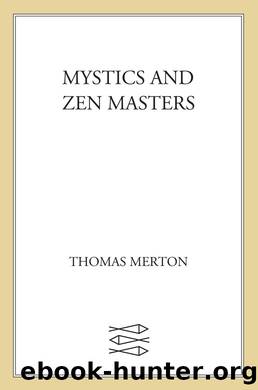Mystics and Zen Masters by Thomas Merton

Author:Thomas Merton
Language: eng
Format: epub
Publisher: Farrar, Straus and Giroux
Published: 2011-04-18T00:00:00+00:00
It is interesting in this connection to study a monastic text of the seventeenth century, precisely because it represents a conscious return to the early monastic tradition and registers a protest against the arbitrary imposition of complex methods upon a monastic community that had no need of them.
The text is from Dom Augustine Bakerâs Inner Life and Writings of Dame Gertrude More.12 To appreciate it fully, we must place it in its historical setting. Augustine Baker (see page 146) studied law in the London of Shakespeare and Queen Elizabeth I. Reconciled to the Catholic Church in 1603 and clothed with the Benedictine habit at Pavia in 1605, he became a spiritual disciple and descendent of the great English mystics of the fourteenth century. Baker wrote a commentary on the Cloud of Unknowing, and his Holy Wisdom (Sancta Sophia) is a compilation of various treatises on the contemplative life and contemplation, written in the spirit of Hilton and the Cloud for the English Benedictine nuns of Cambrai.13
One of the foundresses of this Benedictine community in exile was the great-great-granddaughter of St. Thomas More, Dame Gertrude More, who, with Dame Catherine Gascoigne, first abbess of the community, was one of Dom Augustineâs most accomplished disciples.
Dom Augustineâs life of Dame Gertrude is at the same time an exposition and justification of his own doctrine and of the English and monastic tradition of mysticism. Though he was not a scholar of the caliber of Mabillon and the other Maurists, who were about to begin their great work of âreturning to the sourcesâ of monastic, liturgical, and theological tradition, Dom Augustine had been nourished by the monastic fathers. His teaching on prayer is substantially the same as that we find in the Ninth and Tenth Conferences of Cassian, and in the works of St. Gregory the Great. But Baker not only had studied the ancient monastic doctrine on prayer. He had lived it, and from this experience he had recovered the original understanding of the monastic conversatio which was perhaps lacking to some of his fellow monks, trained by post-Tridentine spiritual methods for the active, lonely, and perilous life of the English mission.
The English Benedictine nuns in France and Belgium were troubled and divided by the fact that they were taught many âmodernâ techniques in prayer and asceticism which were entirely alien to their simple contemplative spirit.14
This was definitely the case of the newly founded convent of Our Lady of Comfort at Cambrai. The novice-foundresses were being formed by three nuns from a convent in Brussels who had been brought up according to the ânewâ methods. Dame Gertrude More was reduced by these methods to a state of frustration and confusion bordering on despair. Only the wise guidance of Dom Augustine Baker saved her, and perhaps the convent, from collapse. He preserved the vocations, indeed perhaps the sanity, of the nuns, two of whom at least, by following âFather Bakerâs way,â recovered the ancient monastic spirit and fully experienced the flowering of their monastic vocation in contemplative prayer.
Download
This site does not store any files on its server. We only index and link to content provided by other sites. Please contact the content providers to delete copyright contents if any and email us, we'll remove relevant links or contents immediately.
| Philosophy | Spirituality |
The Way of Zen by Alan W. Watts(5814)
Ego Is the Enemy by Ryan Holiday(4011)
The Art of Happiness by The Dalai Lama(3397)
The Book of Joy by Dalai Lama(3243)
Why Buddhism is True by Robert Wright(2840)
Shift into Freedom by Loch Kelly(2701)
Spark Joy by Marie Kondo(2689)
Happiness by Matthieu Ricard(2535)
A Monk's Guide to a Clean House and Mind by Shoukei Matsumoto(2412)
The Lost Art of Good Conversation by Sakyong Mipham(2131)
The Meaning of the Library by unknow(2079)
The Third Eye by T. Lobsang Rampa(1889)
The Unfettered Mind: Writings from a Zen Master to a Master Swordsman by Takuan Soho(1867)
Anthology by T J(1760)
Red Shambhala by Andrei Znamenski(1753)
The Diamond Cutter by Geshe Michael Roach(1676)
Thoughts Without A Thinker: Psychotherapy from a Buddhist Perspective by Epstein Mark(1598)
Advice Not Given by Mark Epstein(1524)
Twilight of Idols and Anti-Christ by Friedrich Nietzsche(1500)
